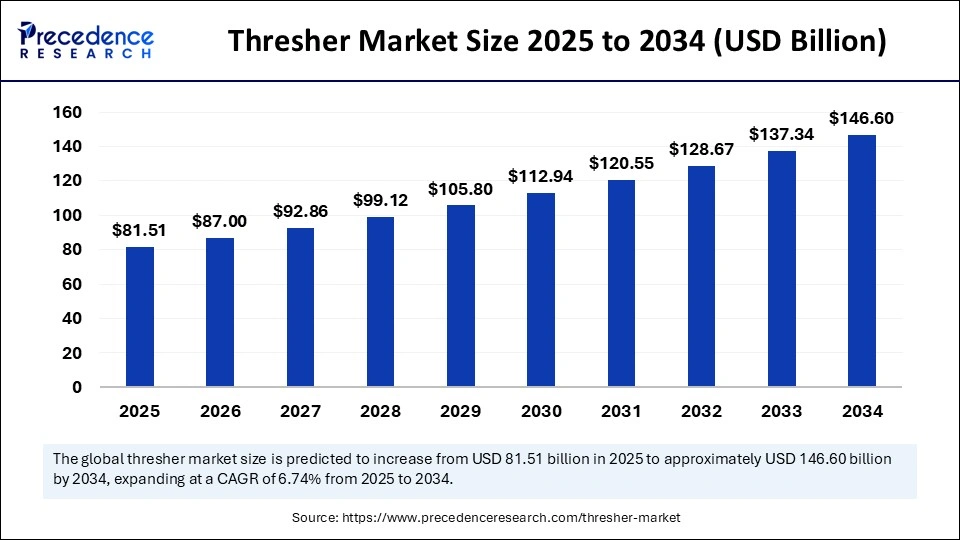
Thresher Market Key Points
-
Asia Pacific dominated the thresher market with the largest share in 2024.
-
Europe is projected to witness rapid growth during the forecast period.
-
By product, the axial flow type segment held the largest market share in 2024.
-
The wire-loop type segment is anticipated to grow at a significant CAGR from 2025 to 2034.
-
By application, the wheat segment led the market in 2024.
-
The rice segment is expected to grow at a notable CAGR in the coming years.
Market Overview
The thresher market plays a vital role in the agricultural machinery sector, contributing significantly to post-harvest operations by separating grains from stalks and husks. Threshers are essential for increasing efficiency in crop processing, reducing manual labor, and minimizing grain losses. They are widely used for crops like wheat, rice, maize, barley, and pulses, and come in various configurations such as spike-tooth, hammer mill, and axial-flow threshers. The global market is driven by the need for mechanized farming solutions, especially in developing regions where agricultural productivity is tightly linked to food security and economic stability.
With increasing demand for food due to population growth, coupled with the shortage of farm labor and the need for faster and more efficient post-harvest processes, threshers have become an integral component of modern farming practices. Government incentives, subsidies on farm equipment, and efforts to promote rural mechanization are further boosting the adoption of threshers across various geographies. In many emerging markets, threshers offer a cost-effective solution for small and marginal farmers, reducing dependency on manual labor while improving overall productivity.
Thresher Market Growth Factors
Several key factors are fueling the growth of the global thresher market. The foremost is the increasing global demand for food and agricultural products, which has intensified the need for faster and more efficient harvesting and processing methods. Threshers help accelerate post-harvest operations, making them critical in ensuring timely crop turnover and reducing losses caused by delays.
The declining availability of agricultural labor in both developed and developing economies is another major growth factor. As urbanization increases and younger generations move away from farming, mechanization becomes essential. Threshers reduce the dependence on manual labor for time- and labor-intensive tasks, offering a reliable solution for farmers.
Supportive government policies and rural mechanization programs are also propelling the market forward. Many countries offer subsidies on farm machinery and promote co-operative ownership models, making threshers accessible to smallholder farmers. Initiatives by agricultural development agencies and NGOs are further enhancing adoption in low-income regions.
Moreover, technological advancements in thresher design, such as higher output efficiency, fuel savings, lower maintenance needs, and compatibility with tractors or mini-harvesters, are making them more attractive to a wider range of users. The emergence of multi-crop threshers that can handle various grains and pulses is also expanding the product’s appeal.
Impact of AI on the Thresher Market
Artificial Intelligence (AI) is gradually transforming the thresher market by enabling smart, automated, and data-driven agricultural machinery. While AI integration in threshers is still in its early stages compared to other agricultural equipment like tractors or drones, its influence is growing as smart farming gains traction.
AI-enhanced threshers can include sensor-based monitoring systems that track parameters such as grain output quality, throughput rates, and machine health in real time. These systems provide feedback to farmers or operators to optimize settings and reduce grain loss or mechanical wear, improving overall efficiency.
Predictive maintenance is another area where AI is making an impact. By collecting data on vibration, temperature, and load during operation, AI systems can predict component failures before they occur. This helps reduce downtime during the critical harvesting period and extends the machine’s operational life.
AI also supports automation of post-harvest processing by integrating threshers with other smart devices, enabling seamless crop handling workflows. For example, AI-based systems can coordinate the timing between threshing, drying, and storage, optimizing overall harvest logistics.
In future scenarios, autonomous threshers or AI-guided operation systems could become viable, particularly for large-scale farms. As connectivity and digital infrastructure improve in rural areas, AI will further enhance the utility and intelligence of threshers, making them more precise, cost-effective, and sustainable.
Market Scope
| Report Coverage | Details |
| Market Size by 2034 | USD 146.6 Billion |
| Market Size in 2025 | USD 81.51 Billion |
| Market Size in 2024 | USD 76.36 Billion |
| Market Growth Rate from 2025 to 2034 | CAGR of 6.74% |
| Dominating Region | Asia Pacific |
| Fastest Growing Region | Europe |
| Base Year | 2024 |
| Forecast Period | 2025 to 2034 |
| Segments Covered | Product, Application, and Region |
| Regions Covered | North America, Europe, Asia-Pacific, Latin America, and Middle East & Africa |
Market Drivers
A key driver for the thresher market is the need to improve post-harvest efficiency. Timely and effective threshing is essential to minimize crop spoilage and ensure quick market access. In regions with short harvesting windows, mechanized threshers are indispensable.
Another significant driver is the rising mechanization of agriculture, especially in Asia and Africa. As farming operations become more commercialized, the use of mechanized tools like threshers becomes essential to maintain competitiveness and output consistency.
Affordability and accessibility of small and mid-sized threshers are also supporting market growth. These machines are increasingly being tailored to the needs of smallholder farmers, offering a balance between cost, portability, and performance.
In addition, the availability of financing options and equipment leasing models is encouraging farmers to adopt threshers without high upfront investments. Banks, cooperatives, and agri-tech startups are offering flexible credit and rental schemes that make mechanization more feasible.
Opportunities
The thresher market holds strong opportunities for innovation and expansion. One major opportunity lies in the development of multi-crop and region-specific threshers, which cater to diverse cropping patterns and terrains. Customization of equipment based on local needs can unlock significant value in both emerging and mature markets.
Electrification and solar-powered threshers are promising areas for innovation, especially in off-grid and remote agricultural zones. These eco-friendly solutions help reduce operational costs and dependency on fossil fuels while promoting sustainable farming.
Another growth opportunity lies in the integration of threshers with digital farm management systems. Linking threshers to mobile apps and cloud platforms can provide farmers with insights on harvest timing, machine performance, and crop output, creating a more data-driven farming ecosystem.
Expansion into underserved regions, such as Sub-Saharan Africa, where mechanization levels are still low, represents a significant opportunity for manufacturers and policymakers alike. Programs that combine training, financing, and service support can help penetrate these high-potential markets.
Challenges
Despite the market’s potential, there are several challenges. One of the most pressing is the high initial cost of mechanized threshers, especially for small and marginal farmers in developing economies. Without adequate financial support or cooperative models, many farmers remain dependent on manual methods.
Lack of awareness and technical skills is another barrier. In several regions, farmers are unaware of the benefits of threshers or lack the training to operate and maintain them effectively. This limits the impact and lifespan of the machines.
Infrastructure and transportation challenges also affect market penetration. In rural areas with poor roads or no electricity, transporting and operating threshers can be logistically difficult, particularly for larger models.
Additionally, seasonal use and low utilization rates can make it hard for individual farmers to justify the investment. This challenge is being addressed through shared ownership or service-provider models, but these are still in the early phases of development in many regions.
Regional Outlook
Asia-Pacific dominates the global thresher market, led by countries such as India, China, Bangladesh, and Indonesia. In India, for instance, government-backed schemes for agricultural mechanization and subsidy programs have significantly boosted thresher adoption. The region’s large farming population, diverse cropping systems, and increasing mechanization efforts make it a hotbed for market activity.
Africa presents a massive untapped potential. The mechanization rate remains low, and governments across the continent are beginning to focus on agricultural productivity. NGOs and donor agencies are promoting thresher access through rural mechanization hubs and cooperative models.
Latin America, particularly Brazil and Argentina, also showcases a growing market, driven by large-scale farming and agri-export demand. Mechanized post-harvest processing is becoming more prevalent, and threshers form a key part of that shift.
North America and Europe have relatively mature markets with high penetration of advanced agricultural equipment. However, the demand here is focused more on high-capacity, smart, and automated threshers for commercial farms and grain producers.
The Middle East, with its arid climate and water conservation challenges, is gradually embracing mechanized agriculture to enhance food security. Threshers compatible with water-efficient cropping systems and smart farm technologies are gaining interest.
Thresher Market Companies

- Mahindra & Mahindra
- Kubota
- Deluxe Agro Industries
- John Deere
- AGCO
- ALMACO
- Bharat Industries
- Iseki & Co
- Alvan Blanch
- Wuhan Acme Agro Tech
- Unnati Threshers
- Hunan Sunfield Agricultural Machinery
- Kovai Classic Industries
- Shandong Guangzhong Machinery
- Rizhao Peakrising International
Segments Covered in the Report
By Product
- Spike-Tooth Type
- Axial Flow Type
- Hammer Mill Type
- Wire-Loop Type
- Others
By Application
- Wheat
- Rice
- Corn
- Groundnut
- Sunflower
- Others
By Region
- North America
- Europe
- Asia Pacific
- Middle East & Africa
- Latin America.
Read Also: Agricultural Pumps Market
Get this report to explore global market size, share, CAGR, and trends, featuring detailed segmental analysis and an insightful competitive landscape overview @ https://www.precedenceresearch.com/sample/6100
You can place an order or ask any questions, please feel free to contact at sales@precedenceresearch.com|+1 804 441 9344